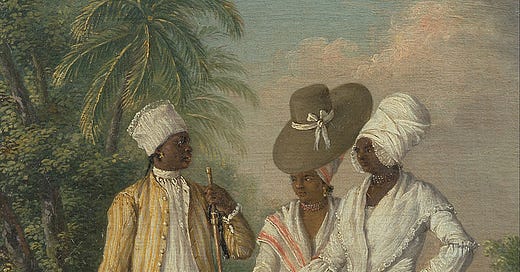Review of Charlton W. Yingling, Siblings of Soil: Dominicans and Haitians in the Age of Revolutions (Austin, TX: University of Texas Press, 2022), pg. 368.
![Free West Indians of Dominica ca. 1770[19] Free West Indians of Dominica ca. 1770[19]](https://substackcdn.com/image/fetch/$s_!jxhC!,w_1456,c_limit,f_auto,q_auto:good,fl_progressive:steep/https%3A%2F%2Fsubstack-post-media.s3.amazonaws.com%2Fpublic%2Fimages%2Fe4f8e683-f635-4b0e-b318-c8b91c72cc17_800x1034.jpeg)
Charlton W. Yingling, a professor of history at Louisville University, takes an understudied topic, the interactions between the people of Haiti and the Dominican Republic in the nineteenth century and argues that these two seemingly hostile groups actually saw themselves in familial terms. Working against nationalistic Dominican narratives, Yingling draws from a host of primary sources from across countless archives. An important topic to cover, this work would have been stronger had the author engaged more fully with the complexities of not only the Haitian Revolution, but also the Haitian control of what is now the Dominican Republic.
Yingling’s purpose is two-fold in crafting this narrative. First, his book highlights what he sees as an antiimperialist, multiracial, and antiracist movement that came directly out of the Haitian Revolution. Yingling argues that Haitian leaders envisioned a liberated island that included not only Haitians but also Dominicans. This vision, Yingling argues, was embraced by Dominicans who eagerly welcomed the Haitians as brethren and liberators. His second argument centers on “the origins of Dominican anti-Haitian sentiment and action.” This narrative traces primarily the “underestimated and ubiquitous role of belief” and how elite Dominican interests led to a rupture in the relations of Dominicans and Haitians.1
One of the greatest strengths of Siblings of Soil is how Yingling demonstrates the interconnection between Haitian and Dominican peoples. From the colonial through the Haitian Revolution, both colonies were deeply connected not only by trade, but by similar desires to control and expand the role of slavery in their colonies. Dominican elites looked enviously on the wealth and power of St. Dominguan planters. Yingling weaves this desire for wealth with the growing relationships between Black Dominguans and Black Dominicans, particularly in the borderlands in the heart of the island. As the Haitian Revolution rocked St. Domingue, Dominicans both Black and white watched the growing revolution with interest and (in the planters’ case) fear, at times supporting the Haitians and at other times opposing the Black liberation movement. Yingling furthermore shows how elites worked to contain the radical implications of the revolution and only reluctantly joined with the Haitian state in 1822. These interconnections show a much more complex world than scholars have traditionally believed.
Part of this interconnection came from Catholicism, which was deeply influential in San Domingue. While Yingling is perhaps over eager to lambast the Catholic church and argue for religion being used by Black enslaved people as merely a tool to resist oppression, rather than deeply held belief, he pays far more attention to the role of faith in determining one’s actions than many other scholars do. In particular, he ought to have done more in exploring the role of Kongo Christianity and the Kongo people’s adherence to the Catholic faith. This likely would have shifted some of his narratives on the role of the church in maroon communities.
However, despite some of the strong points regarding interconnection and religion on the island of Hispaniola, there were numerous issues that made the overall narrative less persuasive. First, Yingling fails to convey the real complexity of the Haitian Revolution. The Haitian Revolution was a slave revolt, however perhaps more accurately this could be considered as civil war in which numerous factions, some entirely Black or white, or some mixed, fought for control of the future of the island. The Haitian Revolution was not merely Black versus white people, especially as creole planters sought to maintain their position near the top of the social structure. This in turn leads to a second problem with Yingling’s narrative, the post-emancipation world of Haiti. Haitians created an empire, followed by a kingdom and republic (of sorts) that were clearly invested in expansion and in developing imperial structures. Yingling avoids and at times obscures the real brutality of Haitian forces who sought to maintain a plantation society on the backs of the lower sorts. Slavery may have been gone, but for many Haitians they were bound to the land by oppressive laws and violent military forces. As Yingling frames the seizure of San Domingo by the Haitians, he makes no room for oppressive policies of the Haitian people. As with many imperialists in the Atlantic world, framing a conquest in terms of humanitarian necessity (see for example Britian’s growth in West Africa) or because of familial ties were key in Haitian leaders’ narratives. This does not take away from the support by some Dominicans for the Haitian occupation or from the role racism played in Dominican independence. However, the framing of Haitians as noble victors fails to capture the imperialist agendas of some early Haitian elites and sanitizes the narrative.
Siblings of the Soil is a fascinating narrative, but one that lacks the complex realities of Haiti. Yingling does good at integrating a vast array of sources to show the interest that some Dominicans had in joining with Haiti. However, by not highlighting the imperialist agenda of Haitian elites, Yingling fails to fully show the realities experienced by Dominicans under Haitian occupation. Crafting Haitian history is fraught with issues. Yet, nothing is gained in mythmaking and hiding the realities of the Atlantic World. Myths merely prolong historical issues and fail to break the present free from the chains of the past.
Robert Swanson
Charlton W. Yingling, Siblings of Soil: Dominicans and Haitians in the Age of Revolutions (Austin, TX: University of Texas Press, 2022), Ch. 1 (eBook).



